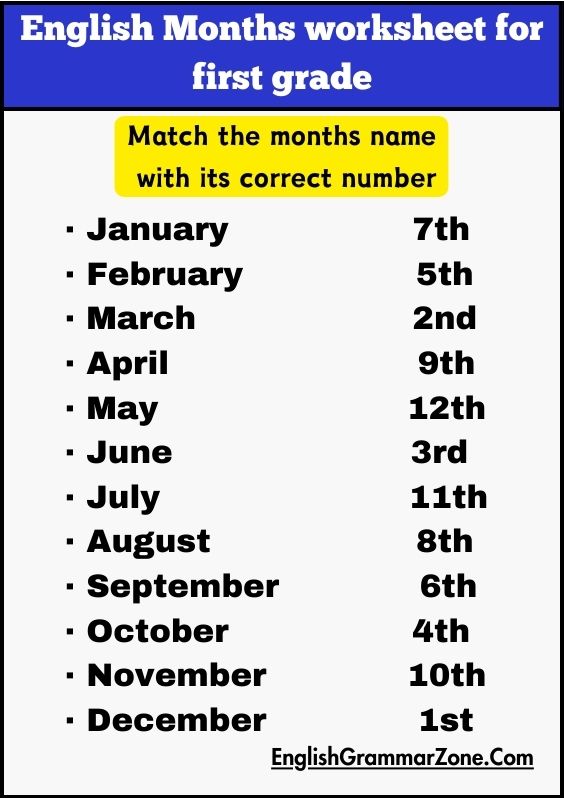Understanding how to matching the month names and numbers is an essential skill in both daily life and various educational settings. Whether you’re planning an event, organizing a project, or simply trying to improve your memory, knowing how to match the month names and number can be incredibly helpful. The months of the year each have a specific number assigned to them, from January being the 1st month to December being the 12th. This simple yet crucial knowledge helps in tasks ranging from scheduling to analyzing data. In this article, we will dive into how to easily match the month names with their numbers and why this information is important.
English Months worksheet for first grade
Match the months name with its correct number
- January – 7th
- February – 5th
- March – 2nd
- April – 9th
- May – 12th
- June – 3rd
- July – 11th
- August – 8th
- September – 6th
- October – 4th
- November – 10th
- December – 1st

Frequently Asked Questions
How can I remember the month numbers easily?
To remember the month numbers easily, consider breaking them down into smaller, more manageable groups. For example, learn the first three months, then the next three, and so on. Using a mnemonic or visual aid, like a calendar, can also help reinforce the relationship between the month names and their numbers.
Is there a trick to remembering the months in order?
Yes! One common trick is to associate each month with a specific event or holiday. For example, you might remember that January is the start of the new year, July is the middle of summer (in many countries), and December is the month of Christmas. This way, you can anchor the months to something you already know and recall their positions more easily.
Why is it important to know the months and their numbers?
Knowing the month names and their corresponding numbers is essential for a variety of tasks. It helps with organization, scheduling, and understanding dates. Whether you’re planning a meeting, completing a project, or studying for exams, being able to match the month names with their numbers ensures you’re on track with timelines and deadlines.
Can I use this knowledge in everyday life?
Absolutely! This knowledge comes in handy in many situations, such as writing formal documents, making appointments, or even booking travel. It helps with keeping track of important events, setting reminders, and avoiding confusion when discussing dates.
Why Is Matching the Month Names and Numbers Important?
Having a clear understanding of the month names and their corresponding numbers is fundamental for several reasons. First, it helps you stay organized. Whether you’re tracking a project deadline, calculating days, or planning a trip, knowing the month order ensures that you don’t mix up your dates. Additionally, this knowledge is essential in both personal and professional contexts, such as writing formal documents, filling out forms, or understanding business reports. By recognizing the month number, you can quickly find specific dates or make informed decisions.
Another reason to know the month names and numbers is their use in academic settings. For students, understanding the relationship between months and numbers is often part of a broader learning objective involving calendars, time management, and chronological order.
In this article, we will cover a few simple tricks to help you match the month names and numbers correctly and efficiently.
How Can I Easily Match Month Names and Numbers?
One of the best ways to match the month names and numbers is to remember a simple list. Here’s how the months of the year correspond to their numbers:
- January – 1st month
- February – 2nd month
- March – 3rd month
- April – 4th month
- May – 5th month
- June – 6th month
- July – 7th month
- August – 8th month
- September – 9th month
- October – 10th month
- November – 11th month
- December – 12th month
A helpful trick to remember this list is breaking it into smaller parts. For example, try focusing on groups of three months at a time. January through March are the first three months, April through June are the next, and so on. Once you remember these smaller chunks, you can easily recall the entire sequence.
Conclusion:
Matching the month names and numbers is a straightforward yet important skill that can help you stay organized, manage your time efficiently, and make better decisions. By learning this information, you will have an easier time navigating schedules, completing tasks, and understanding various documents or reports. Start practicing the month names and numbers today, and you’ll find it becomes second nature in no time.

